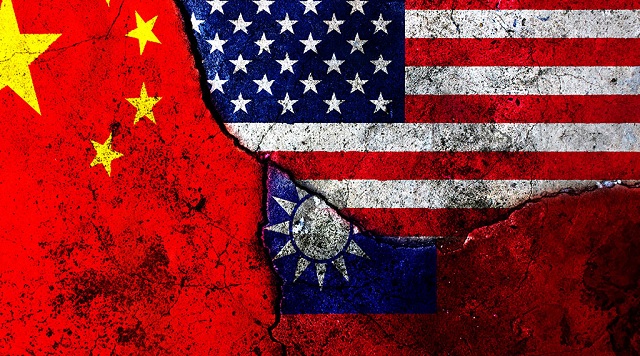China Is Preparing To Challenge The U.S. Over Taiwan

The following essay is an excerpt from Colonel Grant Newsham’s new book, When China Attacks: A Warning to America, due out from Regnery on March 28.
The combination of political warfare, gray-zone actions, and the potential for kinetic warfare come together most clearly around Taiwan, which offers the most immediate prospect of China going on a major kinetic offensive.
Taiwan remains the key objective for the Chinese communists, and Xi Jinping‘s declaration at the 20th Chinese Communist Party Congress in October 2022 that China would use all possible means (i.e., force) to seize Taiwan got loud applause from the audience. It’s presented as unfinished business from the Chinese Civil War. But even more, Taiwan is key to Chinese communist domination of Asia, the Pacific, and ultimately the United States.
Taiwan is where China is getting ready for a war of the sort the Americans will recognize.
It conducted a dress rehearsal in August 2022. The People’s Liberation Army (PLA) established “live-fire exclusion zones” around Taiwan following Speaker of the House Nancy Pelosi‘s visit. The Chinese fired missiles bracketing both Taiwan and southern Japanese islands and conducted a range of naval and air maneuvers towards Taiwan.
Was this an act of war?
The U.S. administration apparently doesn’t think so, and the Chinese communists are glad to let it think that. To the Chinese, however, it is war. Or at least a test run.
One American observer described it as follows:
This is not an infantile reaction to the denial of Beijing’s narrative about Taiwan. This is what the Chinese call a “demonstration project” to test how Taiwan and its allies and friends respond to these aerial (and naval) incursions (and missile launches). It gives the PLA the opportunity to measure and evaluate the aggregate Taiwan-U.S. defense umbrella performance from satellite overhead to sub-surface activity under the sea. It’s a tabletop (and field training) exercise in real-time, 3D, to access certain capabilities of the Taiwan-U.S. defense umbrella.
At the same time, Beijing intimidates Taiwan (as well as the Americans, the Japanese, and everyone else) and tests the response. If that response is weak or frightened, it advances China’s thinking and makes it more likely Xi Jinping will issue the “go” order.
Even before the August 2022 Chinese test blockade of Taiwan, the PLA air force’s aerial incursions were a regular feature in the airspace around Taiwan.
A U.S. Marine pilot described to me how one particular incident ties in with an eventual war:
This appears to be an armed electronic warfare reconnaissance team sniffing out Taiwanese aerial defense radars, locations, and arrays. Simultaneously conditioning the Taiwanese and the world to larger and larger intrusions, until one day that lead intrusion package initiates hostilities and takes out a meaningful wedge of [Taiwan’s] anti-access aerial denial systems in an entire sector. [This would create] a breech for the main assault package to enter and attack the remaining radar sites and missiles from the rear. This is not good, nor is it the action of a respectful neighbor.
The PLA has been preparing for an attack on Taiwan for the last 50 years. Since 2016, when Taiwan elected President Tsai Ing-wen (who, unlike her predecessor, was unwilling to kowtow to Beijing), Chinese military pressure on Taiwan has steadily increased. PLA aircraft and ships routinely encroach on Taiwan’s territory and airspace, and the PLA has laid the infrastructure for an assault on Taiwan—should Taipei not concede peacefully.
As mentioned, Beijing is also looking at America’s political condition and strength—domestic and global. This directly affects America’s ability to respond effectively to a Chinese kinetic move against Taiwan. So, disruptions caused by activists burning down American cities, and half the country, and much of America’s elite class (including Republican Never Trumpers) being afflicted with Trump Derangement Syndrome, weigh in favor of going kinetic.
The United States’ economic and financial conditions also weigh into Beijing’s calculations. American supply chain dependency is in China’s favor. This works both ways, but less so if China is sanctions-proof, as it has been trying to make itself. U.S. manufacturing, especially the defense industrial base, has diminished to the point that it cannot produce weapons or build ships and aircraft fast enough (much less repair them) to fight a serious war against a serious opponent that is willing to roll the dice.
America’s heavy indebtedness, high inflation, and out-of-control entitlement (social) spending choking out defense spending are all favorable signs for Chinese planners.
Originally published by Newsweek
AUTHOR
Grant Newsham
Senior Fellow.
RELATED ARTICLE: A dangerous history repeats: Xi Jinping’s regime is insecure and illegitimate
EDITORS NOTE: This Center for Security Policy is republished with permission. ©All rights.


Leave a Reply
Want to join the discussion?Feel free to contribute!